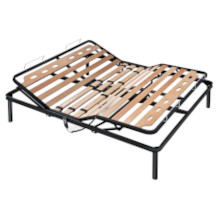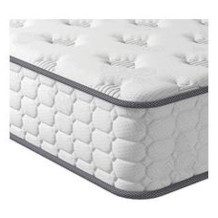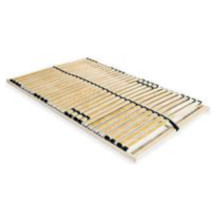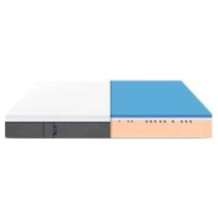Pocket spring mattress purchasing advice: how to choose the right product
- The most important facts in brief
- Pocket spring mattresses have individually packed steel springs inside, which give the mattress point-elastic and breathable properties.
- These mattresses are particularly suitable for sleepers who move around a lot and prefer it cool at night.
- The more you weigh, the higher the firmness level and core height of the mattress should be.
- Compared to barrel and bonell spring mattresses, pocket spring mattresses are particularly high quality because of the mattress core.
- Always let your mattress air out well and rotate it every few months to ensure its longevity.
The classic knows what you need
All too often people complain of back pain, a tense neck or stiff joints. The reason is usually a restless night on an unsuitable mattress, because the right sleeping surface is essential for healthy sleep. Nowadays, the choice is large and accordingly overwhelming. From comfort to latex to cold and visco foam mattresses, there is the right sleeping surface for every body. Today, many consumers swear by the classic mattress again: the innerspring mattress. Manufacturers have optimised the concept, which is why the pocket spring mattress in particular enjoys great popularity these days.
At the latest since the trend of box spring beds has spread from the United States and Scandinavia to Central Europe, pocket spring mattresses have been very popular. The combination of sprung base and innerspring mattress provides incomparable sleeping comfort. The steel springs inside support the body and adapt to its contours. In this way, a pocket spring mattress ensures a straight posture even during sleep and thus prevents back pain as well as pain in the limbs.
What are the advantages of a pocket spring mattress?
A pocket spring mattress has high point elasticity thanks to the individual steel springs. Since the springs are not connected to each other, the mattress hardly vibrates. Even after several years, the mattress core does not develop any hollows because it always returns to its original shape due to the elastic springs. You don’t have to worry about the mattress squeaking loudly during abrupt movements, because any noise is dampened by the special structure of the core. The cavities between the springs in pocket spring mattresses ensure good ventilation: heat is released to the outside and moisture dries quickly. This is why pocket spring mattresses are also particularly suitable for beds with poor air circulation; for example, if there are bed drawers under the bed. The steel springs provide optimal support and promote an orthopaedically healthy posture. In addition, the mattresses, which are slightly harder on average, offer firm sleeping comfort.
What are the disadvantages of a pocket spring mattress?
A pocket spring mattress is comparatively cool: due to the well-ventilated core, it hardly heats up at all, which can reduce sleeping comfort, especially in cold months. Because of the steel springs, a pocket spring mattress is relatively heavy. The high weight makes the mattress unwieldy and difficult to turn and cover. If the steel springs are of inferior quality, hollows can form despite the point elasticity. A pocket spring mattress offers hardly any hygienic advantages if the cover is not removable and washable.
Advantages
- High point elasticity
- Good ventilation
- Low after-swinging
- Long life span
- Quieter than other spring mattresses
- Healthy lying comfort
Disadvantages
- High own weight
- Cavity formation with poor quality
- Hygienically questionable if cover is not removable
Who is a pocket spring mattress suitable for?
Due to its high point elasticity, a pocket spring mattress is ideal for side sleepers: the pelvis and shoulders can sink in while the head and the middle of the body remain straight. The mattress also supports and relaxes the spine. This is especially important for people with back problems. Thanks to the breathability, people who sweat at night or generally like it rather cool will be completely satisfied with a pocket spring mattress. Even if you move a lot during sleep or tend to sleep restlessly and wake up easily, such a mattress is recommended. The insulated springs do not squeak or rub against each other. The good ventilation means that mites have little chance of colonising the pocket spring mattress, and the risk of mould growth is also low. Therefore, it is well suited for allergy sufferers.
Pocket spring mattresses are perfect for all those who
- sleep restlessly,
- sweat a lot,
- suffer from back pain,
- prefer it cool,
- are allergic to dust mites, or sleep on their
- sleep on their side.
What should I consider when buying a pocket spring mattress?
When buying a pocket spring mattress, first decide what size it should be. This includes not only the width and length of the base, but also the height. This is particularly important because you should be able to lie on the mattress without feeling the springs. The degree of firmness is also relevant for the lying comfort. In combination with the number of lying zones, you can adjust the pocket spring mattress to your sleeping needs. The type and number of springs also provide information about the quality of an innerspring mattress. Last but not least, the cover inevitably contributes to the hygiene of the mattress. Look for test seals that provide information about the health compatibility of the materials.
Size matters
Like other types of mattresses, pocket spring mattresses are available in various sizes, both for single and double beds. You only need to consider the size of your bed, because the innerspring mattress sizes do not differ from each other in terms of quality.
| Size in centimeters | Suitable beds |
| 80×200 | Cots |
| 90×200 | Children’s and single beds |
| 100×200 | Single beds |
| 120×200 | Single beds |
| 140×200 | Single and double beds |
| 160×200 | Double beds |
| 180×200 | Double beds |
You should sleep high
For mattresses, manufacturers distinguish between the core height and the total height. The former indicates the height of the springs, while the latter describes the height of the springs including the overlying layer of padding. The higher the mattress core, the better it absorbs pressure. So when you lie on the mattress, no hollows form and your body is kept straight. Heavy people in particular should choose a mattress with a higher core because they tend to sink deeper. To compensate for this, they need a harder mattress. A higher mattress also has more “sinking potential”.
However, the overall height should not be ignored. If the height is too low, you may sink in too far and feel the slatted frame. Your weight also plays a role here. Taller and heavier people should opt for a high mattress. The average core height of pocket spring mattresses is between 15 and 20 centimetres. The total height should be between 20 and 30 centimetres.
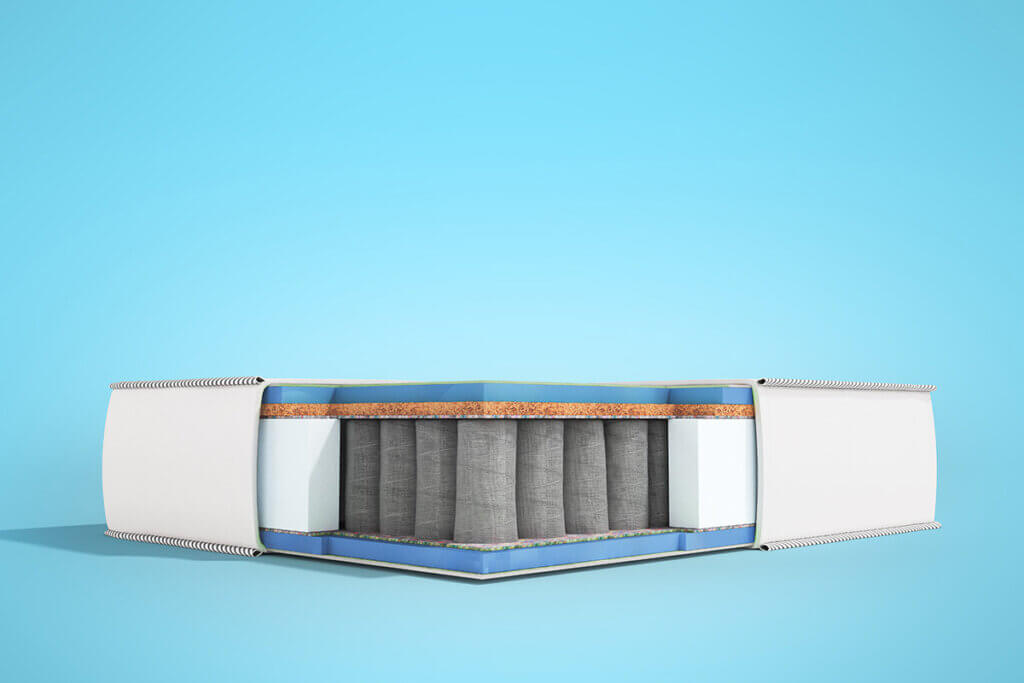
Hard, harder, firmness level
Since for many people there is nothing more unpleasant than having to sleep on a mattress that is too soft or too hard, you should keep an eye on the firmness level when buying your pocket spring mattress. This tells you how hard or soft a mattress is. Hardness levels are divided into five categories and are based on the weight of the person lying on the mattress:
| Degree of hardness | Strength | Weight of the person in kilograms |
| H1 | Very soft | Under 50 |
| H2 | Soft | 50 to 80 |
| H3 | Balanced | 80 to 100 |
| H4 | Hard | 100 to 120 |
| H5 | Very hard | Over 120 |
As a rule of thumb, the heavier your weight, the firmer the mattress should be. Nevertheless, keep in mind that it is not always exclusively a matter of weight. Very tall people are usually also relatively heavy, but the weight is distributed differently. Consequently, the mattress may be somewhat softer than it would be for a smaller person with a similar body weight.
For double beds, there are pocket spring mattresses that have different degrees of firmness. This is particularly interesting for couples where the partners weigh different amounts or have different sleeping habits.
Hardness without degree
The compression hardness should not be confused with the degree of hardness. This is a value given in kilopascals that expresses how much force is needed to compress the mattress core to 40 percent. In addition, the number can be used to derive how quickly the mattress returns to its original shape. The compression hardness of a mattress creates the different degrees of hardness. For a pocket spring mattress, the firmness should be relatively high: The higher the compression hardness, the firmer and more resilient the mattress.
A lying zone for every body zone
Mattresses are divided into lying zones. Basically, the more lying zones a mattress has, the better the spine is supported. However, many lying zones do not mean higher comfort. The number of lying zones should depend on your body size and any “problem zones”: If you have back or joint pain, several lying zones are definitely recommended, but three zones are also perfectly adequate for a healthy lying position.
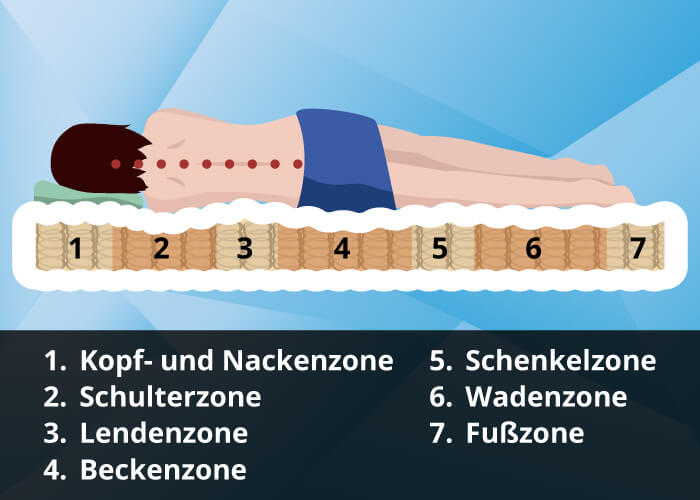
Springs of different strengths are incorporated into the mattress, which yield to the body in certain areas. The shoulder and pelvic area in particular should be lower than the legs and head. This is the only way to ensure a straight and healthy posture during sleep. There are pocket spring mattresses with three, five, seven and nine lying zones. Mattresses with seven lying zones have become the standard because they allow almost every body to achieve an optimal sleeping posture.
The volume weight: interesting but irrelevant
When buying a mattress, you will inevitably come across the term “volume weight”. This indicates how many kilograms of a raw mass have been processed into one cubic metre of foam. Ultimately, the quality of a mattress can be derived from this value. Since this is about the processing of foam, the volume weight is only relevant for foam mattresses made of, for example, cold foam, visco foam or gel foam. For innerspring mattresses with a steel interior, this value is irrelevant.
Quantity for more quality
The more springs in a pocket spring mattress, the higher the point elasticity. High-quality innerspring mattresses should have around 500 springs per square metre. On a total area of 100 x 200 centimetres, this corresponds to about 1,000 springs; you should not opt for a mattress with fewer springs. The fewer springs in a mattress, the further apart they are. As a result, they provide less support and the sleeping surface is more area-elastic than point-elastic.
With many springs used, you can assume that the individual springs are not only very small but also comparatively hard; the lying feeling is correspondingly harder than on mattresses with fewer springs. Furthermore, it can have a negative effect on the point elastic support of a pocket spring mattress if there are too many springs on a small total area.
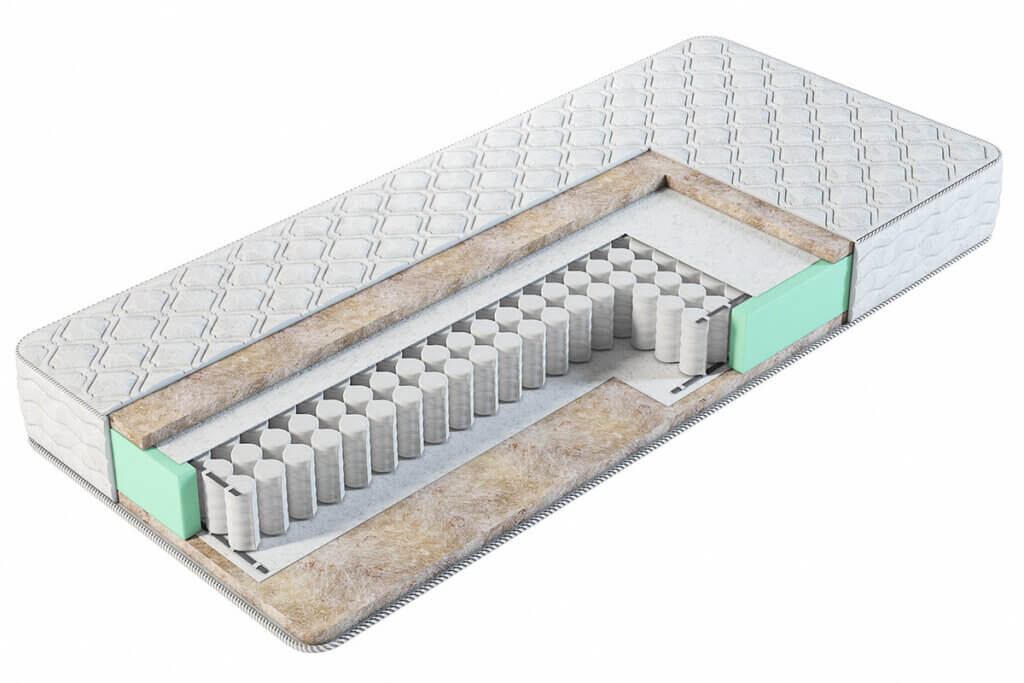
A distinctive design inside
The springs of an innerspring mattress are always made of metal and always have the same shape; there are no differences among pocket spring mattresses when it comes to the type of spring. The interior of pocket spring mattresses differs only in comparison to their type-same competitors: barrel and bonell spring mattresses. The former have thick-bellied springs and the latter steel springs that become wider towards the top and bottom.
Getting into gear
The number of gears in an innerspring mattress provides information about its elasticity. The coils of a spring are called “gears”. The more coils a spring has, the higher the number of coils and the better the spring properties. Which elasticity is right for you should depend on your body weight and sleeping habits. If you have a higher body weight, a mattress with high elasticity is recommended. People who move a lot during sleep should choose a mattress with less elasticity.
The mattress cover
The cover protects the innerspring mattress from dirt and moisture. It is usually made of cotton, cotton blend or polyester/lyocell blend. The cover is breathable and skin-friendly. Make sure that it has a zip and is removable; otherwise it is difficult to clean. If the cover is removable, you can simply put it in the wash; most covers are machine-washable at 40 or 60 degrees Celsius. For example, mattress covers from the manufacturer Schlaraffia are particularly suitable for allergy sufferers, as they can be easily removed and washed at 60 degrees Celsius.
Choose the standard
OEKO-TEX Standard 100 is a testing and certification system for textile products. The testers check whether manufacturers have used legally banned substances or chemicals that are harmful to health when processing their products. Since you sleep on your mattress every day, you should make sure that your new mattress has such a test seal.
The key differences in construction
Pocket spring mattresses have steel springs inside them and are similar to bonell and barrel pocket spring mattresses in this respect. Nevertheless, there is a central difference in the way they are constructed.
How is a pocket spring mattress constructed?
A pocket spring mattress consists of four different layers. Inside is the core of the mattress, which consists of steel springs. The individual springs are sewn into small pockets made of cotton, cotton blend or fleece. These springs sewn into pockets give the mattress its name. They are not connected to each other, which is why each one reacts separately to pressure from outside. Over the core is a layer of fabric, felt or fleece as a protective layer that ensures that the springs do not damage the mattress’ upholstery. The padding layer is made of foam, usually cold or comfort foam, and prevents the steel springs from being felt when sleeping. The final layer is the cover, which encases the entire mattress. It is either firmly sewn or removable with a zip.
What are barrel pocket spring mattresses?
Barrel pocket spring mattresses are similar to conventional pocket spring mattresses in structure and properties. The only difference is the shape of the springs; they are slightly more bulbous, i.e. have a larger circumference towards the centre and are shaped like a barrel when viewed from the side. Because of this shape, barrel pocket spring mattresses offer a better support function than normal spring mattresses. This makes them suitable for people with a high body weight of up to 200 kilograms.
What are bonell spring mattresses?
Bonell spring mattresses are the simplest and oldest form of innerspring mattresses and are usually not of particularly high quality. The steel springs, also known as bonell springs, are wider at the top and bottom than in the middle and are connected by wires. Since the spring on which pressure is applied pulls the surrounding springs down with it, the result is an area-elastic property. This type of innerspring provides a slight swaying effect so that every movement in the bed is noticeable. It is suitable for people who appreciate such springy comfort or who have a slim build. Since these mattresses belong to the inexpensive models, they are often found in hotels and similar establishments.
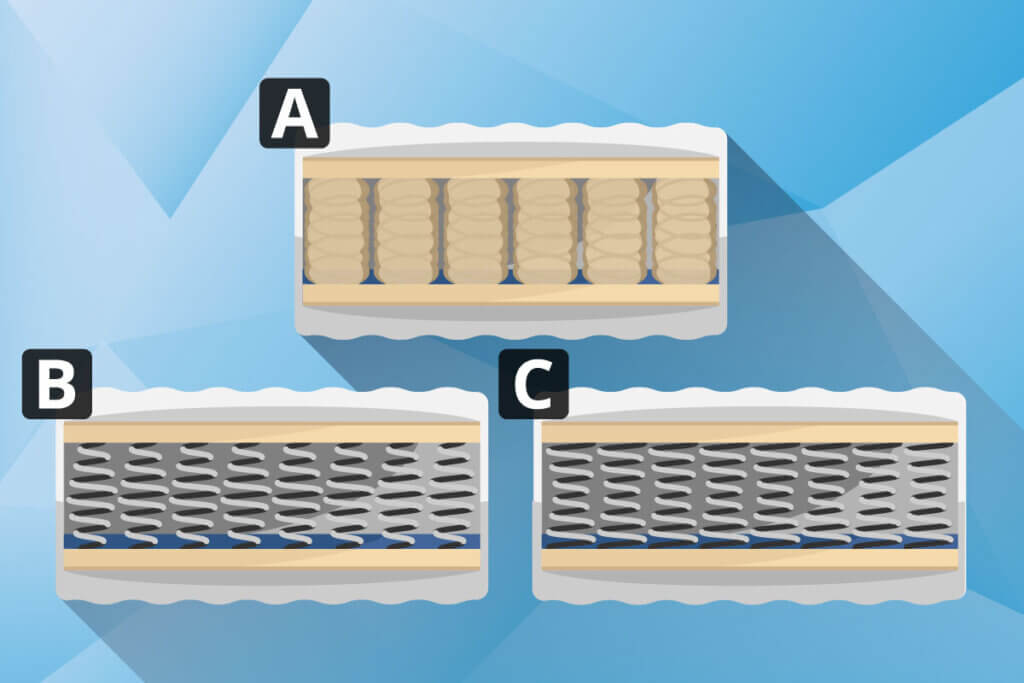
Spring matress or foam matress?
Foam matresses with cold, visco or gel foam inside are recommended for both side and stomach sleepers. Foam is a very elastic material that supports the body but also allows it to sink in enough so that the spine is in a straight position. You should take a look at the lying zones, as foam matresses are also divided to give the body the best possible support. The degree of hardness and volume weight are the most important criteria for buying a matress. In addition, foam matresses are particularly suitable for people who move around a lot at night or sleep restlessly. The soft material adapts to every movement; moreover, no disturbing noises are produced. Last but not least, foam is a material with a low dead weight. The matresses are therefore particularly suitable for older people or people who move frequently.
If you choose a foam mattress, you have a decisive advantage: choice. Since foam is much more flexible to use than steel springs, manufacturers can experiment far more and tailor the mattresses to specific needs. For example, the manufacturer Frankenstolz offers Thermo mattresses, chiropractic-tested and back-friendly as well as recyclable mattresses that have foam in the core.
For the correct use of a mattress
High quality pocket spring mattresses are inherently comfortable to sleep on and are very durable. With the right touch, you can even optimise the lying properties of a premium mattress.
Which slatted frame is needed?
A rigid slatted frame is recommended for a pocket spring mattress so that the mattress is always in a horizontal position and the steel springs are not damaged. Due to the rather stiff mattress core, adjustable slatted frames are only suitable to a limited extent. A sprung slatted frame is also not necessary, as a pocket spring mattress already has springy properties.
However, if you like it more elastic than it already is, you can supplement your pocket spring mattress with a special slatted frame: For example, some slatted frames from the Badenia Bed Comfort Group are made of fibreglass and are thus particularly flexible as well as capable of bearing loads of up to 200 kilograms. The Badenia Group manufacturer Irisette also offers mattress sets that include a matching slatted frame in addition to a mattress.
Always on top
With a mattress topper, you can adapt your mattress even further to your sleeping habits and increase the lying comfort. Such toppers are usually made of latex, gel or cold foam and are accordingly soft. This allows you to combine the comfortable properties of other types of mattress with the supportive properties of a pocket spring mattress. However, remember that the right mattress is crucial for sleeping comfort. A mattress topper cannot cancel out the properties of a mattress, but only support it.
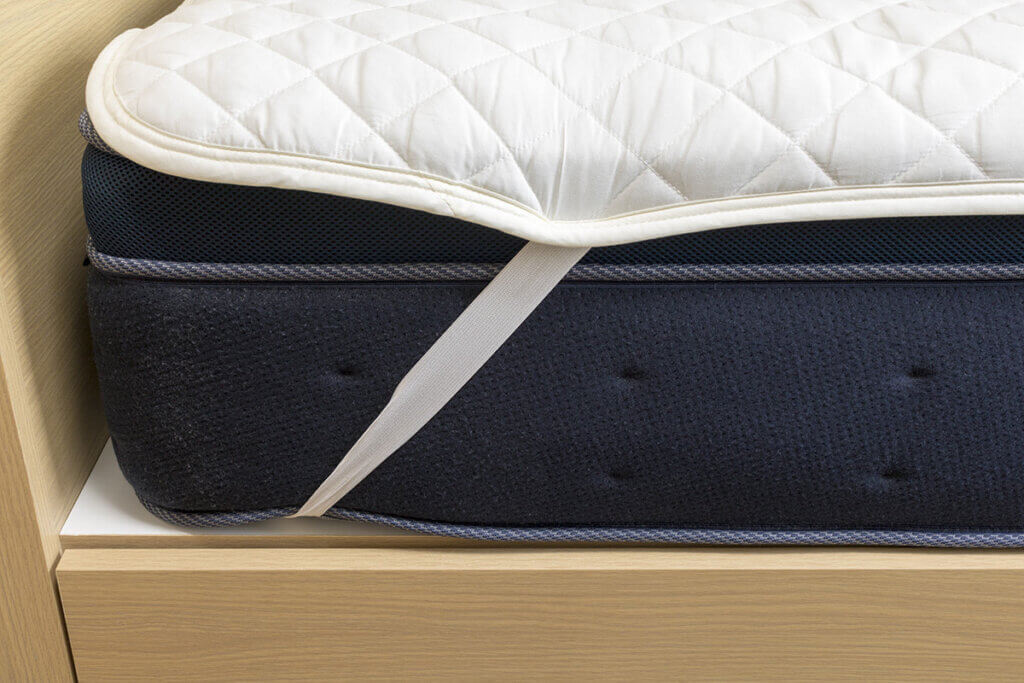
For extra long-lasting pleasure
High-quality pocket spring mattresses are very durable. Most models will last at least seven to eight years; some you can even use for up to 15 years without any problems. Once a mattress has outlived its usefulness, you should consider changing it for reasons of hygiene and comfort. After this time, mattresses lose their support and elasticity.
You have the knack
To ensure the longevity of your pocket spring mattress, you should rotate it every few months. This also makes sense from a hygienic point of view to allow good ventilation of the base. Although it is recommended to turn the mattress every six to eight weeks, it is usually sufficient to turn it once a quarter. In this way, you avoid the formation of hollows. In addition, the mattress is regularly loaded from different sides.
Care and maintenance
With a few care tips, you can increase the longevity of your mattress and also ensure good hygienic conditions in your bedroom:
- Stretch a mattress protector over the mattress to protect the surface. It absorbs liquids and keeps dirt away from the cover.
- Let the mattress air out before stretching a new sheet. This allows it to dry and freshen up.
- Clean the mattress with a hoover including brush attachment to remove coarser dirt such as dust and hair.

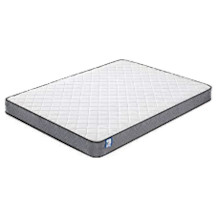
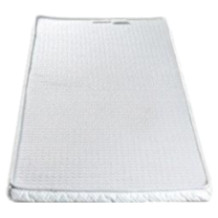
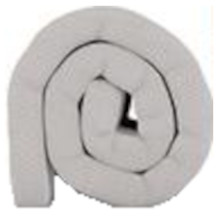
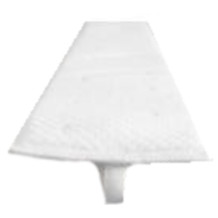
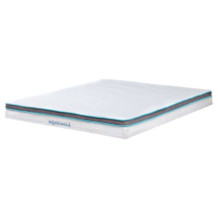
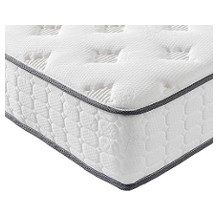
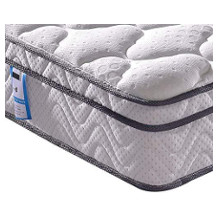
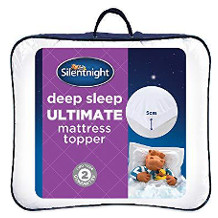
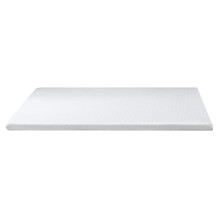
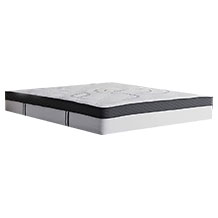

 7,024 reviews
7,024 reviews
